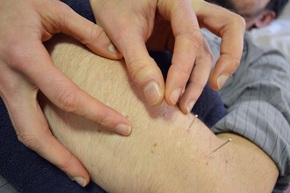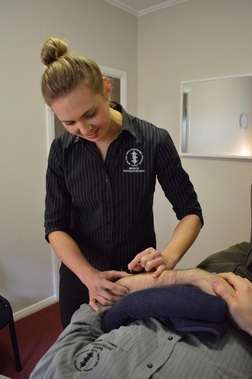- Do you want to know how Dry Needling can help in breaking the pain cycle you are confronted with?
- Do you experience pain caused by muscular disorders such as tension type headaches and migraines, low back pain, elbow pain, knee osteoarthritis, or shoulder conditions?
- Is the pain you are encountering stopping you from participating in activities you want to be doing?
| Dry Needling is a well researched and scientifically proven procedure used to specifically target trigger points in a muscle often caused by trauma, stress, repetitive work, immobilisation, fatigue and various other factors. Trigger points are hyperirritable areas in the muscle tissue and can lead to poor muscle function, and further tissue damage associated with increased pain. |
Unlike Acupuncture, Dry Needling does not consider movements of chi, nor energy pathways in the body for holistic medicinal reasons, but rather focuses on the muscle dysfunction itself. Dry Needling has the ability to reset an overacting or under-acting muscle.
What can I expect during and after the procedure?
Many patients do not feel the insertion of the needle. A local twitch response may be produced once the needle has been inserted into a targeted area, which can be perceived as a small and brief electrical shock. This is a good or desirable response.
After the procedure, mild soreness or a feeling of ‘heaviness’ may be experienced in the local area, with short-lived effects up to 24-48hours. Your response should be discussed with the treating physiotherapist to achieve the most effective treatment duration.
| With strong support in the Western medical world, Dry Needling, when combined with other conventional treatment modalities can: 1. Promote pain reduction, tissue healing and restoration of normal tissue function (in addition to identifying and addressing the underlying sources which may have lead to unhealthy / poor function, muscle damage and pain). 2. Increase energy levels 3. Improve sleep & relaxation Nearly all our physiotherapists at Marion Physiotherapy are qualified in Dry Needling. If you would to try Dry Needling to see if it can help with your pain, please call reception and ask to be booked in with a Dry Needling physiotherapist. |
Kietrys DM, Palombaro KM, Azzaretto E, Hubler R, Schaller B, Schlussel JM, Tucker M 2013, ‘Effectiveness of dry needling for upper-quarter myofascila pain: a systematic review and meta-analysis”, Journal of Orthopaedic & Sports Physical Therapy, vol.43, no. 9.
http://www.ncbi.nlm.nih.gov/pubmed/23756457
Ziaeifar M, Arab AM, Karimi N, Nourbakhsh MR 2014, “The effect of dry needling on pain, pressure pain threshold and disability in patients with a myofascial trigger point in the upper trapezius muscle”, Journal of Bodywork & Movement Therapies, vol. 18. http://www.bodyworkmovementtherapies.com/article/S1360-8592(13)00186-1/pdf
Kietrys DM, Palombaro KM, Mannheimer JS, 2014, “Dry Needling for Management of Pain in the Upper Quarter and Craniofacial Region”, Current Pain and Headache Reports, vol. 18, no. 437.
http://link.springer.com/article/10.1007/s11916-014-0437-0#/page-1
Furlan AD, van Tulder MW, Cherkin D, Tsukayama H, Lao L, Koes BW, Berman BM 2011, “Acupuncture and dry-needling for low back pain (Review)”, Cochrane Collaboration, vol. 1.
http://onlinelibrary.wiley.com/doi/10.1002/14651858.CD001351.pub2/epdf/standard


 RSS Feed
RSS Feed